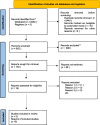Effects of rapid maxillary expansion and functional orthodontic treatment in children with sleep disordered breathing: a systematic review
- PMID: 40604854
- PMCID: PMC12224399
- DOI: 10.1186/s12903-025-06348-w
Effects of rapid maxillary expansion and functional orthodontic treatment in children with sleep disordered breathing: a systematic review
Abstract
Background: Sleep disordered breathing (SDB) in children, characterized by sleep apnea episodes or other episodic or persistent breathing disorders, can be associated with the occurrence of some malocclusions. However, there are few clinical studies on the correlation of the occurrence of malocclusions and the effects of their treatment with reduction of SDB symptoms. Therefore, we conducted a systematic review of this topic, focusing on the population of children during the age of tooth replacement demanding orthopedic treatment for maxillary transverse growth deficiency and anterior mandibular growth modification. This systematic review seeks to assess effect on quality of sleep resulting from Rapid Maxillary Expansion and functional orthodontic treatment in patients with SDB and morphological changes occurring in the oral cavity and upper respiratory tract contributing to the reduction of SDB symptoms.
Methods: The review was conducted in accordance with the Preferred Reporting Items for Systematic reviews and Meta-Analyses 2020 (PRISMA 2020). The study design was defined in the PICO format-Population (P): non-syndromic prepubertal and adolescent patients requiring orthodontic treatment, who additionally have coexisting sleep disorders; Intervention (I): Orthodontic treatment of malocclusion with differentiated appliances; Comparison (C): evaluation of Apnea Hypopnea Index (AHI) and sleep questionnaires pre and post treatment; Outcome (O): effect of orthodontic treatment on sleep quality. Search filters included the time of the publication-articles of 11 last years and publications that was published in English. The following variables were established for the selected articles: sample size, demographic characteristics, orthodontic treatment methods, type of study, AHI (Apnea-Hypopnea Index) parameter. The following scientific databases were searched: PubMed, Embase, Cochrane Central. The articles were analyzed for risk of bias and quality using the Risk Of Bias In Non-randomized Studies-of Interventions (ROBINS-I) protocol.
Results: After entering the keywords, 3,252 articles were retrieved. Of these, 16 articles were deemed eligible for systematic review and were thoroughly analyzed, of which 11 articles did not meet the inclusion criteria. Five articles (n = 248 individuals, 163 girls and 124 boys) aged 8-12.5 years, mean age 10.6, were included in the review. In 124 patients with class II malocclusions or mandibular retrognathia, a modification of the anterior growth of the mandible was used using Twin-Block appliances with the possible use of class II traction, and in 124 patients with bilateral crossbite, the Rapid Maxillary Expansion (RME) method was used. The quality of upper airway patency and sleep quality related to SDB was examined using polysomnographic analysis, polygraphy analysis, cephalometric studies and questionnaires.
Conclusions: The literature review suggests that orthodontic treatment may improve sleep quality, alleviate symptoms of SDB, and enhance sleep parameters however one article does not support this thesis. A close correlation between these phenomena has not yet been fully established. The current review is a good starting point for introducing simpler methods of examining the quality of sleep, in children, which requires further research on this topic. Registration CRD42024565669.
Keywords: Functional appliance; Malocclusion; Quality of life; Sleep apnea in children; Sleep quality.
© 2025. The Author(s).
Conflict of interest statement
Declarations. Ethics approval and consent to participate: Not applicable. Consent for publication: Not applicable. Competing interests: The authors declare no competing interests.
Similar articles
-
Orthodontic treatment for posterior crossbites.Cochrane Database Syst Rev. 2001;(1):CD000979. doi: 10.1002/14651858.CD000979. Cochrane Database Syst Rev. 2001. Update in: Cochrane Database Syst Rev. 2014 Aug 08;(8):CD000979. doi: 10.1002/14651858.CD000979.pub2. PMID: 11279699 Updated.
-
Orthodontic treatment for prominent upper front teeth (Class II malocclusion) in children and adolescents.Cochrane Database Syst Rev. 2018 Mar 13;3(3):CD003452. doi: 10.1002/14651858.CD003452.pub4. Cochrane Database Syst Rev. 2018. PMID: 29534303 Free PMC article.
-
Orthodontic treatment for prominent upper front teeth in children.Cochrane Database Syst Rev. 2007 Jul 18;(3):CD003452. doi: 10.1002/14651858.CD003452.pub2. Cochrane Database Syst Rev. 2007. PMID: 17636724
-
Association between orthodontic treatment and upper airway changes in children assessed with cone-beam computed tomography (CBCT): A systematic review.J Oral Rehabil. 2024 Oct;51(10):2195-2208. doi: 10.1111/joor.13797. Epub 2024 Jul 8. J Oral Rehabil. 2024. PMID: 38978295
-
Education support services for improving school engagement and academic performance of children and adolescents with a chronic health condition.Cochrane Database Syst Rev. 2023 Feb 8;2(2):CD011538. doi: 10.1002/14651858.CD011538.pub2. Cochrane Database Syst Rev. 2023. PMID: 36752365 Free PMC article.
References
-
- Więckiewicz M, Lavigne G, Martynowicz H. Decrypting the putative interrelation between sleep bruxism, masticatory muscle pain and sleep breathing disorders: Nosology and the role of hypoxia. Dent Med Probl. 2024;61(2):165–7. 10.17219/dmp/175686. - PubMed
-
- Foldvary-Schaefer NR, Waters TE. Sleep-disordered breathing. Continuum (Minneapolis, Minn). 2017;23(4):1093–116. - PubMed
-
- Riemann D. Focus on sleep-related breathing disorders. J Sleep Res. 2019;28(5): e12908. 10.1111/jsr.12908. - PubMed
Publication types
MeSH terms
LinkOut - more resources
Full Text Sources
Medical


